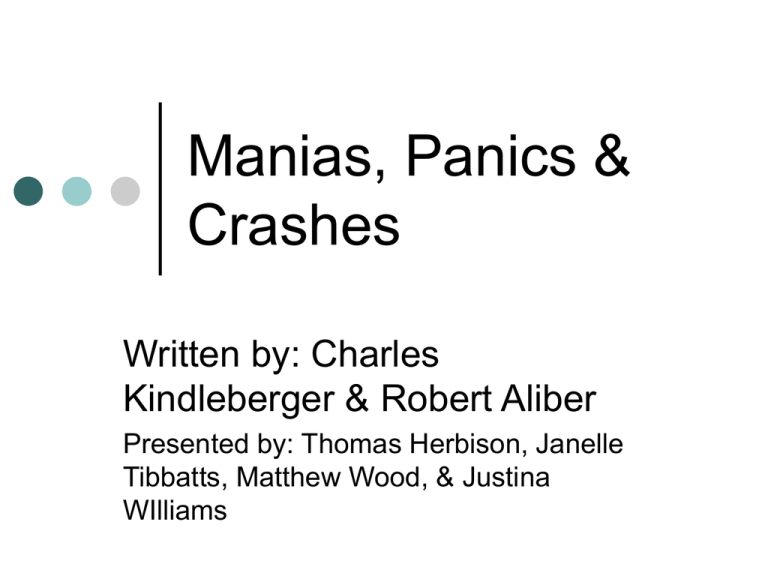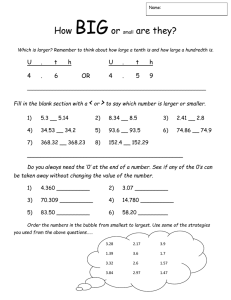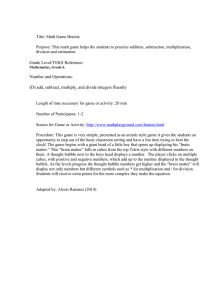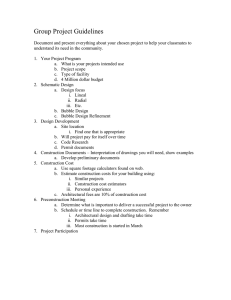Manias, Panics & Crashes Written by: Charles Kindleberger & Robert Aliber
advertisement

Manias, Panics & Crashes Written by: Charles Kindleberger & Robert Aliber Presented by: Thomas Herbison, Janelle Tibbatts, Matthew Wood, & Justina WIlliams Agenda Overview of Manias, Crashes & Panics Explanation of Key Terms & Timeline Rational vs. Irrational Exuberance Video Lenders of Last Resort Frauds & Scandals Current Events Concluding Remarks Overview Charles Kindleberger (1910-2003) Ford Professor of Economics at MIT 5th Edition of “Manias…” Historical perspective Human nature Relevance of topics throughout history “History is philosophy learned through examples” Thucydides, 420 BC Bubbles Bubble: non-sustainable pattern of price changes or cash flows Refers to increases in asset prices in the mania phase of the cycle In this book, a bubble is an upward price movement over period of 15 to 40 months Booms and bubbles are fueled by the expansion of credit Big Ten Financial Bubbles 1. 2. 3. 4. 5. 6. 7. 8. 9. 10. Dutch Tulip Bulb Bubble – 1636 South Sea Bubble – 1720 Mississippi Bubble – 1720 Late 1920s Stock Price Bubble – 1927-29 Surge in Bank Loans to Mexico, Developing Countries – 1970s Real Estate and Stocks in Japan – 1985-89 Real Estate and Stocks in Scandinavia – 1985-89 Real Estate and Stocks in SE Asia – 1992-97 Foreign Investment in Mexico – 1990-93 OTC Markets in the United States – 19952000 Manias Economic euphoria – money seems “free” Associated with expansion phase of business cycle Virtually every mania is associated with a robust economic expansion, but only a few economic expansions are associated with a mania Manias Increases in real estate, stocks, and/or commodities leads to increases in consumption and spending, accelerates economic growth Investors and lenders are optimistic about the future and asset prices increase more rapidly Panics & Crashes Displacement Outside event or shock that changes horizons, expectations, anticipated profit opportunities, behaviour Ex. War – August 1914 Can come as a result of distress sales Price of assets decline below their purchase price, therefore investors sell these assets and prices decline further Often precipitated by revelation of misfeasance, malfeasance, or malversation that occurred during mania Frauds & Scandals Minsky Model Hedge Finance Speculative Finance Anticipated operating income greater than the interest and scheduled reduction of its indebtedness Anticipated operating income covers interest payments, must use cash from new loans to repay portion of maturing loans Ponzi Finance Anticipated operating income insufficient to pay obligations – firm must either increase indebtedness or sell some assets to generate cash Currency versus Banking Schools of Thought Currency School Advocate a firm limit on the expansion of the money supply to avoid inflation Wanted a simple rule to fix the growth rate of the money supply at 2 or 4 or 5 percent Banking School Believe that increases in the supply of money would not lead to inflation as long as these increases were associated with business transactions Increase of the money supply at the start of an economic expansion Timeline Economic Growth Boom, Bubble Panic Mania Crash Boom, Bubble Mania Panic Crash Time Summary Manias are times of euphoria, which can lead to a bubble. When a displacement occurs to “pop” the bubble, panic may ensue and can lead to a crash in the market Minsky Model Schools of Thought Rational vs. Irrational Exuberance Rational versus Irrational Exuberance Rational Buying based upon genuine, fundamental value Irrational Increase that is based upon a speculative bubble - “unsustainable increase in prices brought on by investors’ buying behaviour” Need to understand the value investors have imputed in the market so we can adjust and plan accordingly if the value shouldn’t be there Irrational Exuberance Many parts that play a role in irrational exuberance for the financial world: Structural Cultural Psychological There are also many ways to rationalize exuberance Structural Factors 1. 2. 3. 4. 5. 6. The arrival of the Internet at a time of solid earnings growth Triumphalism and the decline of foreign economic rivals Cultural changes favouring business success or the Appearance Thereof A Republican Congress and capital gains tax cut The baby boom and its perceived effects on the market An expansion in media reporting of business news Structural Factors 7. Analysts’ increasingly optimistic forecasts 8. The expansion of defined contribution pension plans 9. The growth of mutual funds 10.The decline of inflation and the effects of money illusion 11. Expansion of the volume of trade 12. The rise of gambling opportunities Amplification Mechanisms Type of naturally occurring Ponzi process “Investors, their confidence and expectations buoyed by past price increases, bid up stock prices further, thereby enticing more investors to do the same, so that the cycle repeats again and again, resulting in amplified response to the original precipitating factors.” Robert Shiller (2000) Psychological Factors Quantitative anchors – people are weighing numbers against prices when they decide whether stocks (or other assets) are priced right Example: Wheel of Fortune type game Moral anchors – people compare the intuitive or emotional strength of the argument for investing in the market against their wealth and their perceived need for money to spend now Social pressures – such as “group think” Herd behaviour Attempts to Rationalize Exuberance Fama’s efficient markets theory Mispricing The appearance of prices being too high or too low is just an illusion Differing abilities do not produce differing investment performance Priced for the long-run (Jeremy Seigel’s book Stocks for the Long Run) The 1636 Tulip Mania Stock prices roughly track earnings over time – despite great fluctuations in earnings, price-earnings ratios have stayed within a comparatively narrow range Evidence for or against the efficient market theory? Many anomalies have been discovered within the efficient markets theory January effect (stock prices tend to go up between December and January) Small-firm effect (small firms’ stocks tend to have higher returns) Day-of-the-week effect (stock market tends to do poorly on Mondays) Summary Irrational exuberance comes due to many factors: Structural changes Cultural diversification Psychological patterns Society tries to rationalize exuberance through efficient markets theory and other methods Video Lenders of Last Resort Domestic and International Lenders of Last Resort 2 Types 1) Domestic lender of last resort • 2) Reduce likelihood that a shortage of domestic liquidity will cause bankruptcies that wouldn’t have occurred in the absence of distress and precautionary selling International lender of last resort • Provide liquidity to improve the extent of necessary exchange rates and prevent those changes that aren’t required Lenders of Last Resort Should there be a lender of last resort? If investors are confident that they’ll be bailed out by a lender of last resort, their self-reliance may be weakened. Who should the lender be? 1) Domestic lender of last resort • • 2) Central Bank Government (Treasury) International lender of last resort • • International Monetary Fund World Bank Advantages & Disadvantages to the Lender of Last Resort Advantages Crisis or panic can be avoided Bankruptcies can be prevented Disadvantages Expensive Investors become less self-reliant Summary Lenders of Last Resort Domestic International Can help to avoid financial panics and crashes Expensive, investors may be less responsible in the marketplace Frauds & Scandals White Collar Crime Frauds Frauds and illegal activity are closely associated with euphoric periods as some people succumb to greed and try to maximize wealth by all means necessary. As individual wealth increases in times of euphoria and gains of 3040% are realized, trends show an increase in fraudulent behaviour to incur even more rapid gains to their personal wealth. Swindles and the Credit Cycle Swindles, fraudulent behaviour , defalcations, and elaborate hustles are part of life in market economies, more so in some countries than in others. (transparency International) During crashes and tightening of the credit supply, fraudulent behaviour is prevalent as people try to avert large losses and “doubledown,” which in many cases causes financial disaster. (Nick Leeson) Fraud and Euphoria Most fraud occurs in the mania phase and is obscured by the growth of the bubble. Individuals become greedy for a share of the increase in wealth and swindlers come forward to exploit that greed. “There’s a sucker born every minute.” The amount of swindlers increase relative to the amount of “gullible” people entering the market and taking chances. In a euphoria there is a pervasive air of optimism and people believe the market will continue to go up and maintain high returns. Because of an overly positive view of the market, some investors will more easily part with their money and be caught off guard by swindlers. Most often the ‘low class’ swindles involve Ponzi finance. Kozlowski & Conrad Black - Greed grew faster than wealth. White Collar Crime “The 1920’s in the United States has been called ‘the greatest era of crooked high finance the world has ever known’ – but that was before the 1990’s.” Enron, WorldCom, Adelphia, Tyco, Global Crossing, Martha Stewart Reasons 1. Decline in adherence to moral standards 2. Risk-Reward trade-off skewed – stock options provide greater pay for financial success/greed. 3. Companies pay for audit services and can lean on accountants or bribe to produce desired results. Crash and Panic - Try to forestall bankruptcy or financial disaster– Nick Leeson Those who commit white collar crime get off relatively lightly and spend limited time in jail and keep large portions of illegal earnings. i.e. Michael Milken Summary Frauds arise during boom periods, when people want to “keep up with the Jones’ ” Relatively mild repercussions for committing white collar crimes, if you are charged Current Events Shanghai Exchange In January, Chinese exchange traders increased 134% or 1.38 million from a month earlier and stock turnover was up 700% from a year earlier. Contributed to a huge stock surge and a ‘small’ bubble. Bubble popped by Chinese authorities as they launched a ‘special task force’ to decrease the amount of domestic speculative investing and crimping the source of subsidized capital. First time China has become trendsetter in the global market and affected other exchanges because of the decisions made. Shanghai exchange more than tripled in value in 2006 to over $900 billion. Chinas market capitalization was too small to effect global markets two years ago. It now totals around $1.3 Trillion. Current Real Estate Bubble North American Bubble European Bubble Conclusions Thank you for your time







